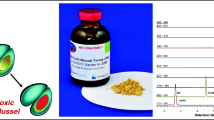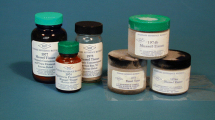Abstract
Two samples of mussels (Mytilus edulis) were collected from the southwest of Ireland. One sample contained domoic acid, the other sample contained okadaic acid, dinophysistoxin-2 and azaspiracid-1, -2 and -3. Wet and freeze-dried reference materials were prepared from each of the two samples to test for differences in homogeneity, stability and extractability of the analytes in either condition. Wet materials were homogenised, aliquoted and hermetically sealed under argon and subsequently frozen at −80 °C. Dry materials were similarly homogenised but frozen in flat cakes prior to freeze-drying. After grinding, sieving and further homogenisation, the resulting powder was aliquoted and hermetically sealed. Domoic acid materials were characterised using HPLC–UV, while LC–MS was used for the determination of lipophilic toxins. The extractabilities of all phycotoxins studied were comparable for wet and freeze-dried materials once a sonication step had been carried out for reconstitution of the freeze-dried materials prior to extraction. Homogeneity was assessed through replicate analysis of the phycotoxins (n = 10), and was found to be similar for wet and freeze-dried materials, for both hydrophilic and lipophilic toxins. Water contents were determined for both wet and freeze-dried materials, and particle size was determined for the freeze-dried materials. Stability was evaluated isochronously over eight months at four temperatures (−20, +4, +20 and +40 °C). The freeze-dried material containing domoic acid was stable over the whole duration at all temperatures, while in the wet material domoic acid degraded to some extent at all temperatures except −20 °C. In freeze-dried and wet materials containing lipophilic toxins, okadaic acid, dinophysistoxin-2, azaspiracid-1 and azaspiracid-2 were stable over the whole duration at all conditions, while concentrations of azaspiracid-3 changed significantly in both materials at some storage temperatures.

Aliquots of freeze-dried and wet mussel tissue reference materials containing the various shellfish toxins examined in the study





Similar content being viewed by others
References
Van Egmond H (2005) Validation issues and CRMs. Oral presentation at the Wiley Award Symp of the 2005 Annual Conf of AOAC, Orlando, FL
Hess P, McCarron P, Quilliam M (2006) Fit-for-purpose shellfish reference materials for phycotoxins in internal and external quality control. Anal Bioanal Chem (in press) DOI 10.1007/s00216-006-0792-8
NRC-CNRC Institute for Marine Biosciences (2006) Certificates of Analysis NRC CRM-ASP-Mus-c and NRC CRM-DSP-mus-b. NRC-CNRC Institute for Marine Biosciences, Halifax, NS, Canada
Quilliam, MA, Reeves K, MacKinnon S, Craft C, Whyte H, Walter J, Stobo L, Gallacher S (2006) Preparation of reference materials for azaspiracids. In: Deegan B, Butler C, Cusack C, Henshilwood K, Hess P, Keaveney S, McMahon T, O’Cinneide M, Lyons D, Silke J (eds) Molluscan shellfish safety. The Marine Institute, Galway, Ireland, pp 111–115
McCarron P, Burrell S, Hess P (2006) Effect of addition of antibiotics and an antioxidant, on the stability of tissue reference materials for domoic acid, the amnesic shellfish poison. Anal Bioanal Chem (in press) DOI 10.1007/s00216-006-0833-3
McCarron P, Kotterman M, de Boer J, Rehmann R, Hess P (2006) Feasibility of irradiation as a stabilisation technique in the preparation of tissue reference materials for a range of shellfish toxins. Anal Bioanal Chem (in press) DOI 10.1007/s00216-006-0935-y
Quevauviller P, Maier EA (1999) Interlaboratory studies and certified reference materials for environmental analysis: the BCR approach (Techniques and Instrumentation in Analytical Chemistry, vol 22). Elsevier, Amsterdam
EC (2002) Commission Decision 2002/225/EC of 15 March 2002 laying down detailed rules for the implementation of Council Directive 91/492/EEC as regards the maximum levels and the methods of analysis of certain marine biotoxins in bivalve molluscs, echinoderms, tunicates and marine gastropods. Off J Eur Commun L75:62–64
EC (2002) Commission decision of 15 March 2002. Establishing special health checks for the harvesting and processing of certain bivalve molluscs with a level of amnesic shellfish poison (ASP) exceeding the limit laid down by Council Directive 91/492/EEC. Off J Eur Commun L75:65–66
Harkin AL, Bogan Y, Gillespie J, Hess P, Slater J (2004) The efficiency of extraction of domoic acid at different concentrations from a range of shellfish species. Poster presented at the 5th Int Conf Molluscan Shellfish Safety, 14–18 June 2004, Galway, Ireland
Lamberty A, Schimmel H, Pauwels J (1998) The study of the stability of RMs by isochronous measurements. Fresenius J Anal Chem 360:359–361
Quilliam MA, Xie M, Hardstaff WR (1995) Rapid extraction and cleanup for liquid chromatographic determination of domoic acid in unsalted seafood. J AOAC Int 78(2):543–554
Hess P, Kilcoyne J, Swords D, Mulcahy N, McCarron M, Keogh M, Gibbons B, Ronan J (2006) Impact of HPLC-UV methods (solid-phase extraction/UV detection and photodiode-array detection) for the determination of domoic acid on quality of results and sample turn-around time. In: Deegan B, Butler C, Cusack C, Henshilwood K, Hess P, Keaveney S, McMahon T, O’Cinneide M, Lyons D, Silke J (eds) Molluscan Shellfish Safety. The Marine Institute, Galway, Ireland, pp 77–80
McCarron P, Hess P (2006) Tissue distribution and effects of heat treatments on the content of domoic acid in blue mussels, Mytilus edulis. Toxicon 47:473–479
McCarron P, Hess P, Quilliam M (2006) Stability issues in the development of certified reference materials for the shellfish toxins, azaspiracids. Oral presentation at 120th Annual AOAC Conf, 17–21 Sept 2006, Minneapolis, MN
Hess P, Nguyen L, Aasen J, Keogh M, Kilcoyne J, McCarron P, Aune T (2005) Tissue distribution, effects of cooking and parameters affecting the extraction of azaspiracids from mussels, Mytilus edulis, prior to analysis by liquid chromatography coupled to mass spectrometry. Toxicon 46:62–71
International Organisation for Standardisation (ISO) (2003) In vitro diagnostic medical devices-measurement of quantities in biological samples-metrological traceability of values assigned to calibrators and control materials. ISO 17511:2003. Geneva, Switzerland
Acknowledgements
We would like to acknowledge the technical assistance of the staff in both the Reference Material Processing group at the IRMM and the Biotoxin Chemistry team at the Marine Institute. The authors would also like to thank Franz Ulberth (IRMM) for his valuable input in the planning and organisation of this study. The Marine Institute and the National Development Plan (NDP) provided funds to the ASTOX project (ST/02/02, 2003–2006). BIOTOX is an EU-funded project under FP6 (project no. 514074).
Author information
Authors and Affiliations
Corresponding author
Rights and permissions
About this article
Cite this article
McCarron, P., Emteborg, H. & Hess, P. Freeze-drying for the stabilisation of shellfish toxins in mussel tissue (Mytilus edulis) reference materials. Anal Bioanal Chem 387, 2475–2486 (2007). https://doi.org/10.1007/s00216-006-1104-z
Received:
Revised:
Accepted:
Published:
Issue Date:
DOI: https://doi.org/10.1007/s00216-006-1104-z




